Analysing the economic viability of GUARDIAN: current challenges and expected outcomes
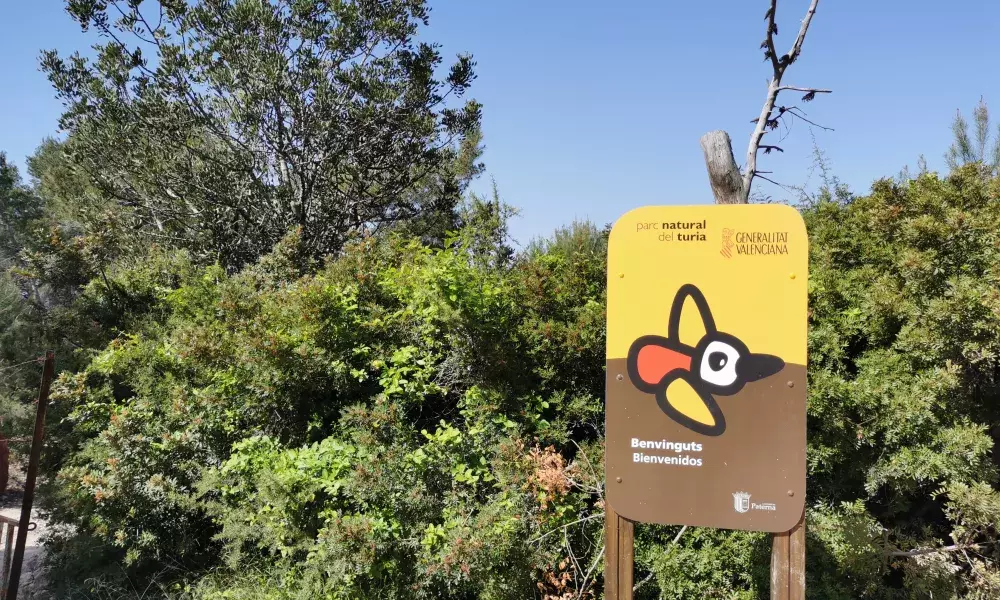
GUARDIAN is already a reality in some areas of Túria Natural Park and is on everyone's lips after the pilot tests carried out this last summer. Neighbours, authorities, fire practitioners are amazed with the firefighting infrastructure put in place yet some of them are also curious (and even sceptical!) about the economic viability of the project. Will the money spent in GUARDIAN be worth it? Will the project be sustainable? Will GUARDIAN be effectively replicable in other fire-prone zones? To start answering these questions, we will try here to summarize the background and methods used by Prof. Francesc Hernández’s team at Universitat de València (UV) to demonstrate that YES, our project will be economically viable if we account for the huge social and environmental benefits and we compare it with the tremendous inaction costs that would appear in case of an unprotected WUI at Riba-roja and Paterna.
GUARDIAN activities are aimed at reducing wildfire risk at Riba-roja and Paterna municipalities. However, there will be further benefits derived from the project implementation that will contribute to making life much better in this area. GUARDIAN will hence ensure La Vallesa ecosystem services, understood as the set of benefits that ecological processes and natural structures offer to human society. Ecosystem services are diverse by nature, including provisioning services such as food, water, timber, etc.; regulating services that affect climate, diseases, water quality; cultural services that provide recreational, aesthetic, educational services and supporting services such as photosynthesis, or nutrient cycling. In turn, the benefits for people can be expressed by different types of constituents of well-being, like health, security, basics for a good life (adequate livelihoods, enough food and shelter, etc.) or good social relations. Adapted from the Millennium Ecosystem Assessment Report, a summary of ecosystem services and impacts is shown in Figure 1. The reading is just a must to understand the essential relation between conservation of ecosystems and human well-being!
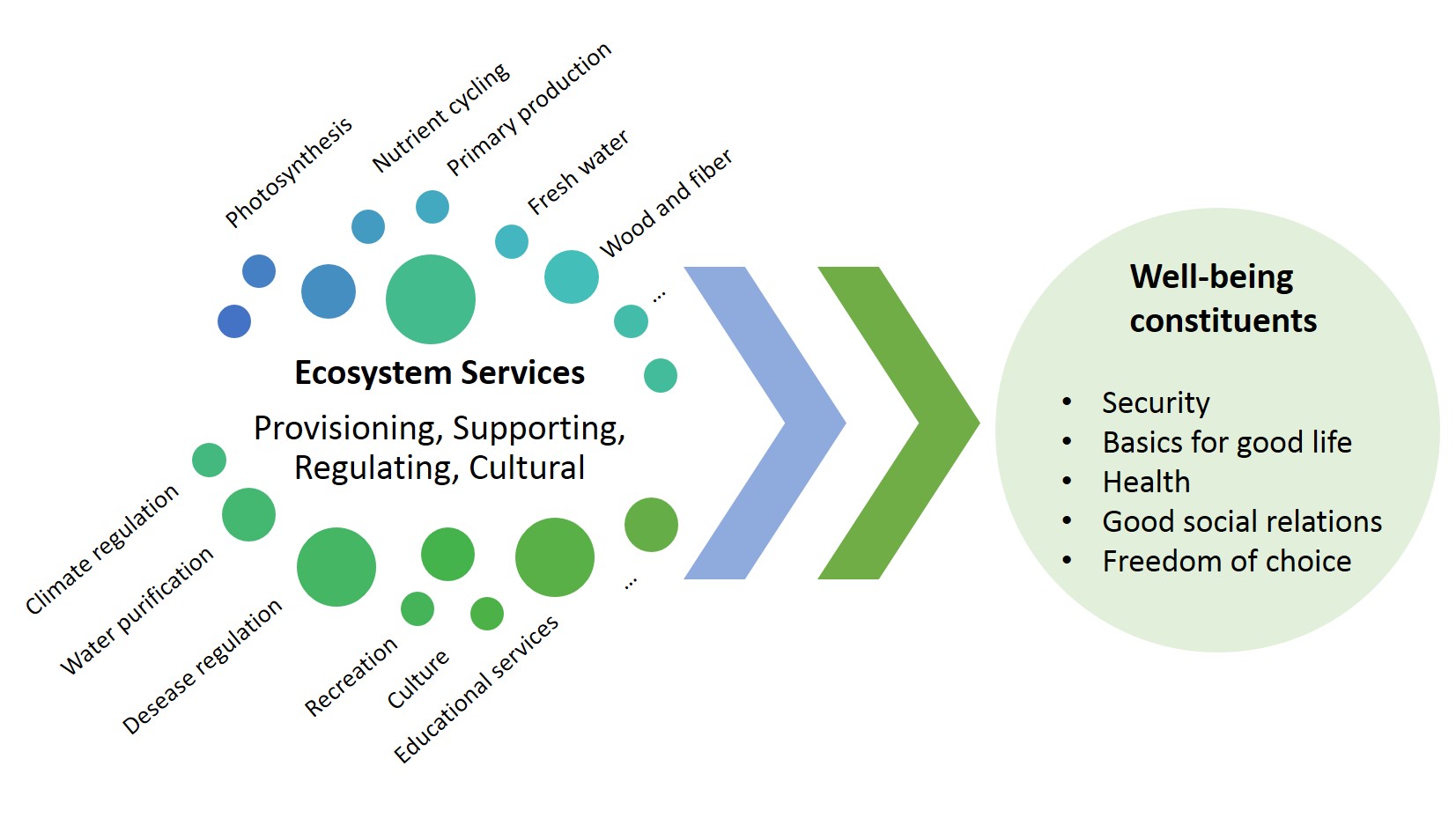
Indeed, GUARDIAN will promote several ecosystem services in La Vallesa Natural area, like biodiversity conservation, water availability, recreational services and natural disaster risk reduction. It is well acknowledged by everyone that all these will lead to multiple social and environmental benefits in Riba-roja and Paterna and have to be somehow considered in the GUARDIAN economic balances and hence be qualified in monetary terms. As Mr. Conca (manager of EPSAR, the public entity for residual water management at Comunidad Valenciana) puts it “what is not quantifiable does not exist” so the challenge here is to clearly identify and quantify all direct and indirect benefits together with all implementation costs and do the maths. The concept is straight forward but the techniques to do so are not that simple!
The viability of GUARDIAN will be analysed through a Cost-Benefit Analysis (CBA) which is a widely accepted and used methodology to evaluate the economic viability of projects. In a CBA, the analyst sums the potential rewards expected from a situation and then subtracts the total costs associated with taking that action considering, in both terms of the summation, intangible items if relevant. As such, it is an analysis of the expected balance of benefits and costs, including an account of any alternatives and the status quo. Let’s briefly describe the basic phases of a CBA:
- Definition of the set of alternatives. The CBA is carried out with the objective of comparing the net profit of various alternatives. In most cases the alternative to project development is the status quo, i.e. not implementing any alternative. In this case, the costs of non-action must be established (Figure 2).
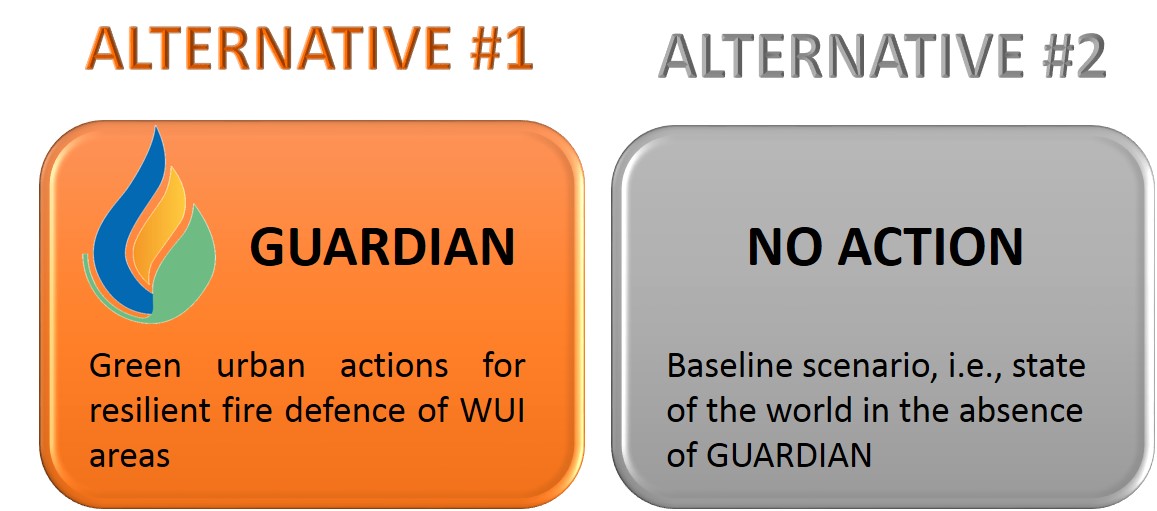
Figure 2. In the CBA, the state of the world in the absence GUARDIAN should be also analysed. - Identification of the costs and benefits. The analyst has to decide whose costs and benefits should be recognised. Two separate lists should then be compiled going beyond the obvious, i.e. including, apart from direct costs and benefits, indirect and intangible items!
- Quantification of the costs and benefits. This constitutes the most complex phase of the CBA. Internal impacts can be easily quantified because they have market value but projects involving impacts from ecosystem services, such as GUARDIAN, present greater complexity as those have no market value. The challenge here is to standardize the units of measurement and express all items in terms of money!
- Calculation of the net profit, defined as the difference between benefits and costs. A project is economically viable if this quantity is positive. When evaluating the economic viability of various alternatives, the best option is the one with the highest net profit.
- Sensitivity analysis. As CBA must rely on assumptions that are quite often best guesses, it is critical that it contains an explicit sensitivity analysis that discusses key assumptions in the base case analysis and varies those assumptions to see how a change affects the analysis.
- Final recommendation. The final step of CBA is making a recommendation. The alternative that generates the greatest net benefit will be selected as the most appropriate.
The operation of the CBA is relatively simple, as it consists of identifying and evaluating in monetary terms all the benefits and costs of the action and their subsequent aggregation to obtain the appropriate indicators to evaluate whether a project is economically viable. The difficulties arise when quantifying costs and benefits being these later even more challenging in the GUARDIAN project as they don’t have direct monetary impact. Fortunately, Prof. Hernández and his team, with a wide experience on economic and environmental feasibility studies for projects involving water management and circular economy have the clue to overcome these difficulties and assess in €€ all costs and benefits derived from GUARDIAN.
In the next paragraphs you will find the basics of the methods that scientists at the Water Economics Group (UV) are using to assess GUARDIAN feasibility. I’ll try to keep it simple, but don’t hesitate to contact them if you need further details.
UV scientists are performing the GUARDIAN costs analysis by using Life Cycle Cost (LCC) concept. In studies using LCC, the costs of a project are assessed over its life cycle including initial capital costs, maintenance costs, operating costs and the asset's residual value at the end of its life. According to ISO 15288, the life cycle of any investment in capital goods consists of successive phases: concept, development, use, maintenance and retirement or replacement (Figure 3). However, note that the existence of these phases does not imply that the resources consumed in each of them are of the same amount.
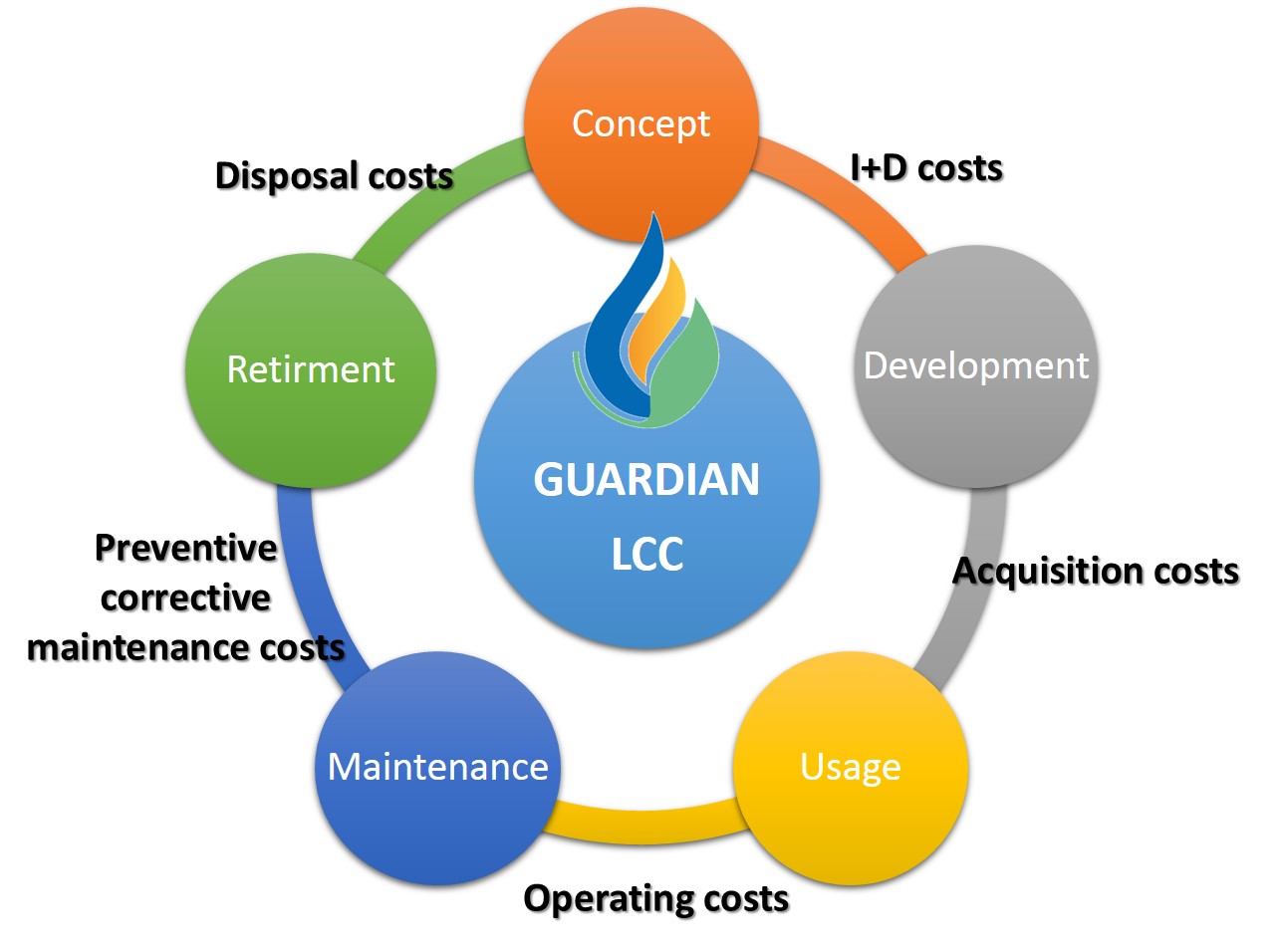
The following LCC cost categories considered and quantified in GUARDIAN are:
- Acquisition costs. These are all costs associated with the initial investment plus the research and development costs, corresponding to the engineering and construction activities, testing, transfer and logistics support.
- Operating costs, which respond to the variable costs derived from the operation of GUARDIAN according to the planned activity (energy, membranes, etc.).
- Maintenance costs. They reflect the consumption of resources derived from preventive and corrective maintenance, repairs, modifications and / or modernizations, to ensure the availability of the overall system (water tanks, water canyons, pumps, pipelines, etc.).
- Withdrawal costs, those costs corresponding to the dismantling, elimination, scrapping or disabling of the system, respecting all environmental and safety requirements.
In the CBA study of GUARDIAN, scientists are seeking for concrete figures of these types of costs to assess economic viability. In addition, they are also studying cost behaviour patterns to assess replicability of the project. They want to understand how data interact and what variables explain the investment, operation and maintenance costs (e.g. extension of land to be protected, number of water canyons, capacity of the water reclamation plant, etc.). This information will be obtained with multiple regression statistical models and will be key to scale up and replicate the project in other fire-prone areas with vulnerable interfaces. I will hopefully share with you this information in future articles, but this is just work in progress by now…
We all know that GUARDIAN is about obtaining social and environmental benefits (what is known as externalities) at Riba-roja and Paterna municipalities. UV scientists are now making a thorough identification and quantification of all of them. To do so, they are asking themselves questions like: What are the resources that the Water Reclamation Plant is providing? To what extent GUARDIAN will help conserving La Vallesa natural area and its environmental wealth? What is the value of GUARDIAN helping to protect assets and people in case of fire? How much money does all this represent?
As we have already highlighted, economic evaluation of ecosystem services, although challenging, can help to demonstrate the benefits that ecosystems bring to people and, in our case, to demonstrate the economic viability of GUARDIAN. To this end, diverse methods and techniques have been developed by environmental economists in these last decades, and some of them are currently under study by UV team:
The Hedonic Price Method, which assigns a value for ecosystem services by estimating the statistical relationship between the evaluated system attributes and another good or service for which there is a market value (Figure 4).
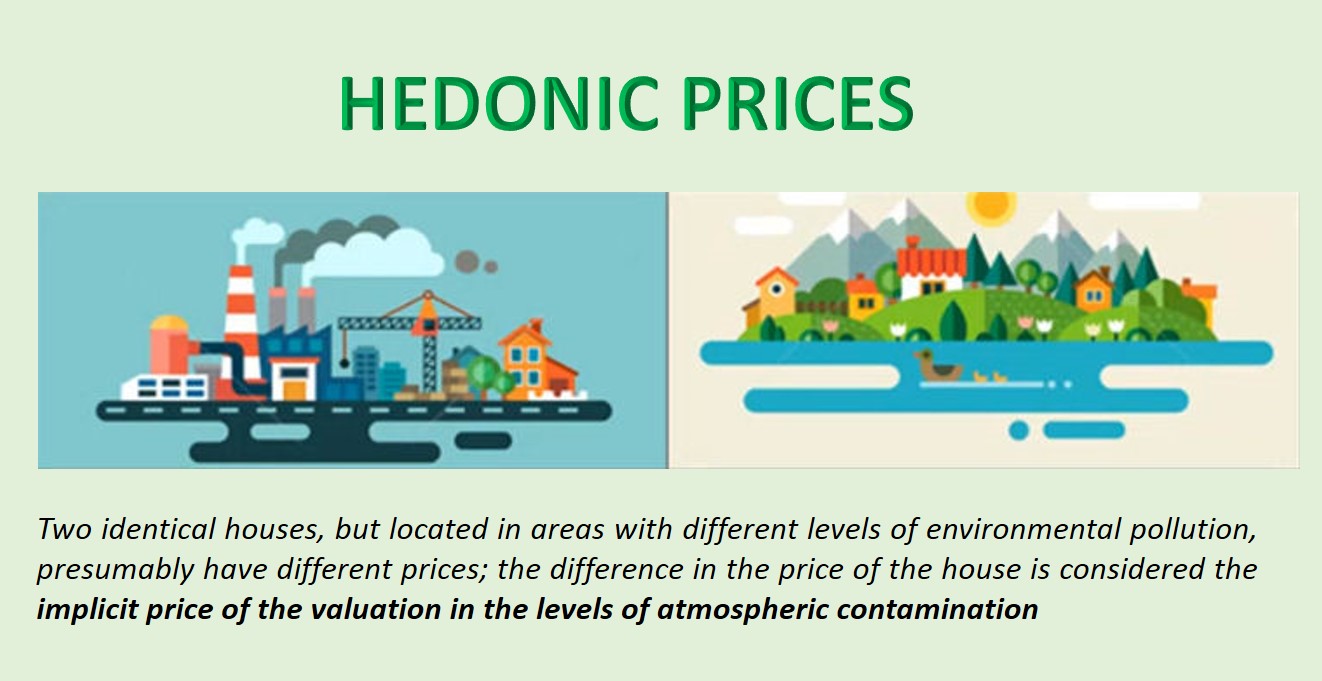
- The travel cost method, is a technique designed to measure in monetary terms benefits derived from visiting recreation areas. The cost of travel is considered an approximation of the price that visitors are willing to pay for ecosystem services.
- Contingency assessment method. It is based on the valuation of the environmental benefits according to the economic amount that potential beneficiaries would be willing to pay or would disburse to maintain it. This value is obtained directly through a series of surveys or interviews to affected people in which questions like “How much would you be willing to pay to increase the protection of La Vallesa, to recover the park, and to reduce the risk of fire?” “Would you be willing to accept compensation for eventual inaction if nothing is done to protect Vallesa? would be posed in the framework of the GUARDIAN project.
- The shadow pricing method. Shadow pricing is the practice of assigning a monetary value to an item, commodity, or service that is not ordinarily bought and sold in any marketplace. Based on complex mathematical programming, a market is projected (an environmental market in our case) and, from this, it is derived what the expected price of a particular environmental good would be. It is also used for the valuation of goods of a cultural nature, or goods that have a great social value but that the market does not grant.
According to prof. Hernández:
The shadow pricing technique will give us great results but it needs a large amount of initial information from all the actions and from the entire natural area where we want to reduce fire risk. We will use this technique in parallel with other available methods to ensure our results are robust and meaningful
No doubt he and his team will succeed in this exciting job of proving GUARDIAN sustainable, reproducible and economically viable. I can’t wait to show you some figures supporting it...stay tuned as this certainly will be the content of final posts!
About this resource
The Urban Innovative Actions (UIA) is a European Union initiative that provided funding to urban areas across Europe to test new and unproven solutions to urban challenges. The initiative had a total ERDF budget of €372 million for 2014-2020.
Similar content




